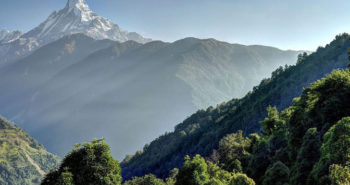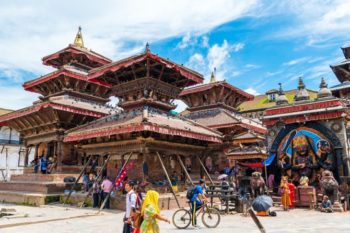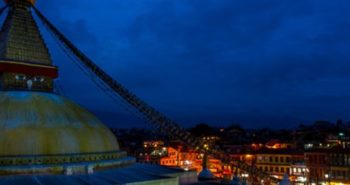Manaslu Trek Packing List
It is not an easy task to pack the right things for the Manaslu circuit trek. From 600 m at Soti Khola, to 5,179 m over the Larke Pass, you will have to hike through different weather and conditions.
You need to plan ahead and what to take on your journey. If not, you might fill up your backpack with unnecessary items and have no space left for the important ones.
Many of the trekkers complain that they had bought unnecessary kinds of stuff for the trek. How great would it have been if they knew what they had to pack?
So, we have come up with the ultimate packing list for trekking in Manaslu Region.
There are some things you need to know before packing though.
Tips to pack for Manaslu Region
You can buy/rent gear in Kathmandu
You can get to buy or rent the necessities like a down jacket, tents, backpacks, shoes, etc. in Kathmandu. The best quality local brands are Sherpa Adventure, KAEMP 8848, Sonam, and Raiko.
I personally use KAEMP 8848 gear. You can buy from their showroom in Thamel or from their factory in Baneshwor.
You can find branded companies like North-face and Mountain Hardwear in Nepal as well.
You can also opt for renting those things for cheap if you don’t want to take it back to your country. I recommend Goreto Gear Traders for renting and buying gear that you need for trekking. They are centrally located in Thamel, here is a link to the location map.
Leave items in the hotel
It is always recommended to travel light even though you are hiring a guide. If you have unnecessary things for the trek like souvenirs, you can leave those in the hotel.
Manaslu trek is a circuit trek. So, you can’t leave your stuff on the way and expect to pick it up on the way back!
You better leave everything in Kathmandu.
Complete packing list for Manaslu Region
Sun Protection
In Nepal, the days are usually very sunny for around 300 days in 365. Many people take the sun for granted. Don’t! You’ll regret it.
Sunglass
The sun is really strong in the high altitude. Especially if there is snow, it reflects the light and might blind you at times.
So, it is better to get dark and UV protection sunglasses.
Sunhat
Same with sunglasses, you also need to protect your face, neck, and even your scalp. If not, you might damage or even lose your hair!
So, a good sun hat is important. Make sure that it is light to wear and easy to pack.
Sunscreen
When the snow reflects the light, it might give you severe sunburn. It is very important to use a high-SPF sunscreen and apply it regularly.
Headwear
Warm hat
It becomes really cold at night in higher altitudes. So, you need to wear a warm hat when you sleep too. A heat retention that is preferable.
Buff
A buff is a versatile piece of fabric. It can be used as a headband, a cap, a mask, a neck gaiter, a balaclava, and many more.
It keeps your neck warm and prevents lips from getting dry. It protects you from sun, wind, dust, and bugs too. Use the one that wicks the moisture away.
Bodywear
Underwear
You have to walk for a long period of time, the least you want is the underwear to chafe your skin or retain the moisture.
It is important to use moisture-wicking material like Merino wool or nylon. These materials take off the moisture from your body.
Also, it better be quick-drying as you will need to pack it and trek the next day.
Sports Bra
For the ladies, you need ease of movement with your bra. You don’t want spillovers and uncomfortable situations while on the road.
The sports bra needs to wick the moisture away and keep you dry throughout the day.
Keep a couple of pairs of comfortable sports bras.
Baselayer
The base layer is the first layer you are going to wear at higher altitudes of trekking. It is very important to select the moisture-wicking one as it is the closest to your body.
The base layer must be warm and comfortable.
Trekking shirt
The trekking shirt also should be made of moisture-wicking material to stay dry and fresh. Pack at least 4 trekking shirts as you will be wearing those every day.
Fleece Jacket
The fleece jacket is for warmth. It acts as insulation and keeps you warmer than just wearing a big bulky jacket.
Once you wear it under your outer insulated jacket, no cold can get you.
Outer Jacket
Rain jacket
If you are planning to trek from June to September, you will need a good rain jacket to protect you.
Along with the rain jacket, get the backpack cover as well.
Trekking trousers and shorts
When you are at a lower altitude to hike, it might get really very hot. So, you might need hiking shorts for lower altitudes and hiking trousers for higher.
Mensuration pad or tampons
It is highly recommended for ladies to carry it. You can’t buy it on the Mountain
Handwear
Inner Gloves
The inner gloves work as a base layer that you will wear under the insulating gloves. It also helps to do minute work with your fingers.
Outer Gloves
The outer gloves protect you from the cold, wind, and snow. It needs to be waterproof and keep you warm.
Footwear
Hiking socks
Hiking socks are important to keep your leg toasty. Make sure to use the moisture-wicking material as it is most prone to smell.
Thermal socks
After a long day of walking, you will need to change to a fresh warm pair of socks. The nights are colder so you should wear thermal socks when you go to sleep.
Hiking boots
A good quality hiking boot is important with ankle support. It is also important to get waterproof boots to stay warm and elongate the life of the boot.
Get the right size shoe and break it in before you challenge the trek. You wouldn’t want blisters on the first day of the trek.
Trainers or trekking sandals
After the long hours of trekking, you will need trainers to walk comfortably around the area. If you like to wear trekking sandals, be sure to wear warm socks underneath.
Gaiters (Recommended in Early Spring (Mid Feb to Mid March) and Winter (Mid-December to Mid Feb)
If you are planning to trek in monsoon season, gaiters are good to keep your boots dry from the inside.
However, you can also use it to prevent mud, stones, and even leeches.
Backpacks
Duffle bag
You will be amazed to see how much you can stuff in a duffle bag. They are easier to pack and unpack.
If you are using Porter then using the duffle bag is the best option.
Note: Magical Nepal provides Duffle bags to its clients.
Backpack
If you are planning to trek alone without the help of the porters then you might want to go for the backpack.
Daypack
If your porter is helping to carry your bag, then you can carry a daypack. Keep the essentials like water bottles or hydration bladder, camera, mobile, passport, and wallet.
Sleeping accessories
Sleeping bag
You are expected to bring a sleeping bag by yourself on the trek. So, carry a good compact down sleeping bag that is easy to carry but warm enough in cold nights.
Note: Sleeping bag can be rented in Kathmandu ($1/day)
Sleeping bag liner
You insert the sleeping bag liner inside your sleeping bag for warmth. It also helps you keep the sleeping bag clean for a long time and increase its durability.
Accessories
Trekking Poles
Trekking poles are a must while trekking. It helps to take off the burden from your knees. It is especially important when you are descending.
Get a lightweight and foldable trekking pole.
Headlamp
A headlamp is very easy to use and you don’t need an extra hand!
If you want to take a night walk or have to start the journey very early, you might need a headlamp. Also, as some tea houses are poorly lit, it will be helpful to have one.
Microspikes
The microspikes have small spikes which can help you walk on moderate ice or snow. They are very light in nature and is perfect for light packers.
Water bottle or Hydration Bladder
You will need to hydrate yourself regularly as there is a risk of altitude sickness. You need to take a water bottle or a hydration bladder that fits your bag.
You can buy mineral water bottles but it will add to pollution. Also. they will charge you high in higher altitudes.
Technology
Camera
Needless to say, you will want a good camera to snap the beauty of your journey. If you want, you can also get a wearable camera to record from your viewpoint.
Portable/Solar Charger
While carrying electronics like a camera, mobile phone, etc. you will need to charge. In cold weather, the battery discharges pretty quickly. So, get a good power portable charger. Note: You have to pay extra to charge your phone in a teahouse.
Books
You will have plenty of time in tea houses and lodges to indulge yourself in a good book. Carrying an e-book reader is best for travel rather than the physical one.
Why?
One, you can read at night without a complaint of low lighting in the lodges. And two, no need to carry a couple of big fat books.
Other necessities
Passport/money
Keep your passport and extra money with you at all times. Keep a copy of your documents like your passport, insurance, bookings, etc. with you.
Insurance
Get insurance. It is important. You might need medication or even a helicopter rescue.
Make sure your insurance covers two things, the elevation of 5167 meters and helicopter rescue service. We recommend World Nomad
Quick-drying towels
While trekking, you are always on the go. You will not have much time to wait for the towel to dry.
Get light and quick-drying towels.
Medication
First aid kit
Are you on any kind of medication? Then bring that along.
In Nepal, you do not need a prescription to buy the medicines. So, you can buy medicines easily here.
Get a first aid kit as you never know when you might need it.
Water purification tablets or Lifestraw
As mentioned above, do not buy mineral water bottles. Take your own water bottle or hydration bladder.
Use water purification tablets, drops or use a Lifestraw.
You can buy water purification tablets and drops in Nepal.
Isotonic Powder
The Isotonic powder will recover your energy from the workout. It also helps the water absorption.
Just add it to your drinking water and you are good to go.
Wet wipes and tissues
Do not expect to find tissues in the upper regions of Nepal. You will need to get your own. Be sure to pack extra in case you get a cold and runny nose.
You might not get to shower every day. Wet wipes are great alternatives for wiping your body.
Lip Balm
Your lips might chap easily when you are at higher altitude. Get a lip balm with SPF to protect your lips from the sun.
Toiletries
Keep all the toiletries you will need. Biodegradable shampoos, face wash, deodorant, toothbrushes, toothpaste etc. You are to take those yourself.
Hand Sanitizer
It is a very quick and easy way to disinfect your hands when you are on the go.


